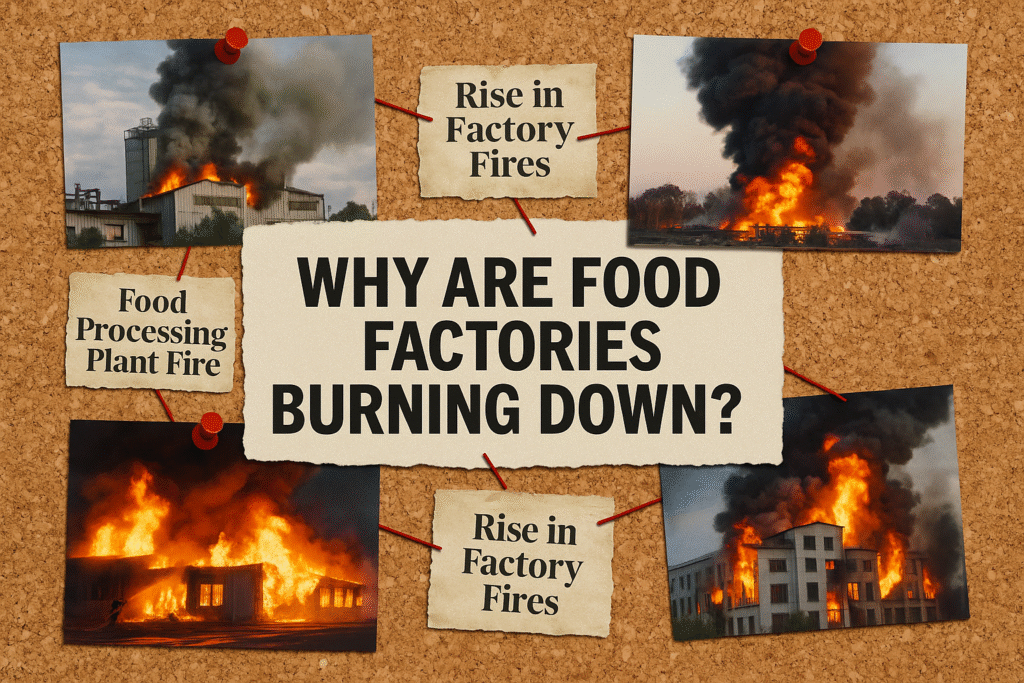It started with a headline.
Then another.
And then another.
A poultry plant catches fire.
A food processing facility explodes.
A bakery burns to the ground.
And just like that, a pattern begins to emerge. Or… does it?
You’ve probably seen the posts:
“Why are so many food factories burning down lately?”
“Is someone sabotaging the food supply?”
“Is this part of the Great Reset?”
Let’s talk about it. No gaslighting. No eye-rolling. Just a real look at what’s happening — and what might be happening behind what’s happening.
The Pattern That’s Got People Talking
By 2022, dozens of headlines about fires, explosions, and closures at food facilities had circulated online. Many posts shared long lists — sometimes 20, 30, even 100+ incidents — hinting that this wasn’t just bad luck.
The theories came quickly:
- Intentional sabotage to disrupt food supply chains
- Agenda 2030 or Great Reset tactics to create scarcity
- A prelude to rationing, digital currency, or dependence on government food systems
- Even “burn it all down” strategies to justify fake meat, lab-grown food, or insect protein
When you’re already skeptical of government narratives and global coordination, these events start to look a little too coordinated.
But Is There Actually a Spike in Food Facility Fires?
Here’s where things get interesting.
When researchers and journalists dug into the numbers, many found that:
- Fires at food plants aren’t new
- The total number of incidents in recent years was within normal historical ranges
- Food supply chains are massive — with tens of thousands of facilities globally
- The events getting attention were a tiny fraction of overall production capacity
So while the incidents were real — the sense of a global uptick was more about pattern recognition than data.
We’re wired to spot patterns — even when they aren’t statistically significant. Especially if they confirm a fear we already have.
Why This Theory Feels True — Even If It’s Not
The food system is fragile. Most of us don’t grow our own food. A few corporations control huge swaths of supply. Add in inflation, shipping delays, and climate disruptions — and you get a recipe for anxiety.
So when we hear about a factory fire, our brains go:
“Of course they’re coming for the food next.”
Even if the event is unrelated.
Even if it has a simple explanation (equipment failure, aging infrastructure, etc).
Even if there’s no direct impact on supply.
The fear still feels real.
And that fear makes the story stick.
The Real Risks Are Bigger Than Fires
Here’s the twist:
Focusing only on factory fires might actually distract us from the real threats to our food system.
- Corporate consolidation — fewer companies controlling more of the supply
- Monoculture and soil degradation — which makes crops vulnerable to collapse
- Climate chaos — floods, droughts, and fires affecting entire regions
- Worker exploitation — in farming, processing, and transport
- Surveillance-based agriculture — where big data starts to dictate who eats and who profits
These are systemic. Ongoing. Deeply real.
But they’re harder to meme.
So… Are Food Factories Being Burned on Purpose?
There’s no solid evidence of a coordinated effort to burn food plants in North America or globally.
But there is evidence of:
- Failing infrastructure
- Underfunded safety systems
- Increasing pressure on supply chains
- And yes, the occasional suspicious case — which should be investigated, not dismissed
You don’t need to believe in a master plan to believe the system is vulnerable.
And you don’t need to chase shadows to stay awake.
Stay Alert — Without Getting Played
Not every fire is a conspiracy.
But not every “debunk” tells the whole story either.
The goal isn’t to blindly trust anyone. It’s to think for yourself — on purpose.
Question the system.
Ask who benefits.
But stay grounded. Stay clear. Stay human.




